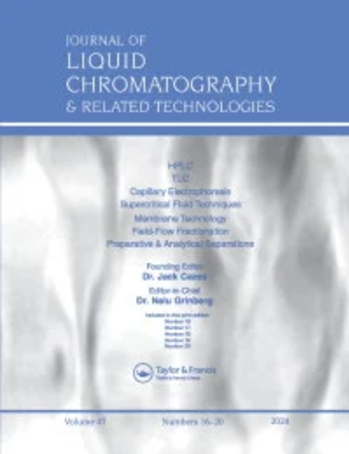用LC-Q-TOF-MS/MS鉴定奈沙地尔新型水解降解产物及其在硅毒性预测中的应用
IF 1.2
4区 化学
Q4 BIOCHEMICAL RESEARCH METHODS
Journal of Liquid Chromatography & Related Technologies
Pub Date : 2022-02-25
DOI:10.1080/10826076.2022.2089999
引用次数: 1
摘要
摘要根据ICH和世界卫生组织指南,对新型青光眼药物耐塔舒地尔进行了强制降解研究。在C-18柱上利用乙酸铵缓冲液(10 mM,pH 4.90)作为流动相a,乙腈∶甲醇(70:30)v/v作为流动相B。注射量为10 µL,0.8 mL/min流速。检测波长245 nm,在40的恒定柱温下进行研究 °C。最初,根据LC-MS-TOF/MS数据对药物的质量裂解途径进行了假设,随后对降解产物进行了表征。随后对降解产物进行LC-MS/TOF研究。在碱性和酸性条件下观察到显著的降解,而在其他分解环境中没有观察到药物的显著下降。共形成四种降解产物,并借助高分辨率质谱进行表征。建立了netarsudil形成所有DP的机制途径。此外,使用在线网络服务器Pro Tox II建立了药物和降解产物的比较毒性特性。图形摘要本文章由计算机程序翻译,如有差异,请以英文原文为准。
Identification and characterization of novel hydrolytic degradation products of netarsudil by LC-Q-TOF-MS/MS: In silico toxicity prediction
Abstract A forced degradation study on novel glaucoma drug netarsudil was performed as per ICH and WHO guidelines. All the degradation products were separated from the drug on a C-18 column utilizing ammonium acetate buffer (10 mM, pH 4.90) as a mobile phase-A and acetonitrile: methanol (70:30) v/v as mobile phase-B, by employing gradient elution mode. The injection volume was 10 µL with a 0.8 mL/min flow rate. The detection wavelength was 245 nm and the study was executed at a constant column temperature of 40 °C. Initially, the mass fragmentation pathway of the drug was postulated followed by characterization of degradation products from LC-MS-TOF/MS data. This was followed by LC-MS/TOF studies on the degradation products. Significant degradation was witnessed in alkaline and acidic conditions whereas no signification decline in the drug was observed in other decomposition environments. A total of four degradation products were formed and characterized with the aid of high-resolution mass spectrometry. The mechanistic pathway of formation of all DPs from netarsudil is established. In addition, comparative toxicity properties of the drug and degradation products were established using the online web server Pro Tox II. Graphical Abstract
求助全文
通过发布文献求助,成功后即可免费获取论文全文。
去求助
来源期刊
CiteScore
2.80
自引率
0.00%
发文量
29
审稿时长
4.9 months
期刊介绍:
The Journal of Liquid Chromatography & Related Technologies is an internationally acclaimed forum for fast publication of critical, peer reviewed manuscripts dealing with analytical, preparative and process scale liquid chromatography and all of its related technologies, including TLC, capillary electrophoresis, capillary electrochromatography, supercritical fluid chromatography and extraction, field-flow technologies, affinity, and much more. New separation methodologies are added when they are developed. Papers dealing with research and development results, as well as critical reviews of important technologies, are published in the Journal.

 求助内容:
求助内容: 应助结果提醒方式:
应助结果提醒方式:


